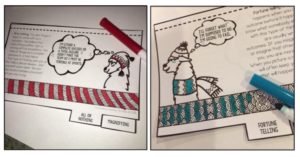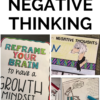Empower students to escape negative thinking traps by guiding them to reframe negative thoughts. Once students identify these cognitive distortions, real change can begin. These thoughts hold them back and keep them from their full potential. In cognitive behavioral therapy, there are dozens of thinking errors that cause the mind to believe things that are just not true. Let’s look at five of the most common distortions and how to reframe them.
5 Negative Thought Patterns and How to Change Them
Stewing
Dwelling on thoughts is a common distortion. When you repeat negative thoughts or a bad experience over and over in your mind, you begin to lose sight of the positive things around you.
Reframe: Recognize when an intrusive thought is taking over. Become intentional about stopping the thought. Replace the thought with happy thoughts. Come up with a list of things that make you happy. Start a journal of blessings and refer to it often.

Magnifying
When you draw conclusions that are not justified, based on limited information, you are overgeneralizing. Like the old saying goes, you are “making a mountain out of a molehill.” Overreacting to a minor issue is common. Example: I failed a quiz, so I will always fail.
Reframe: To reframe this negative thought pattern, focus on the big picture in life. Goal setting is one way to do this. Move on and realize that you have the power to change and do better. Be able to make mistakes and forgive yourself.
All or Nothing
This distortion means that you see things in black and white with no gray areas. You believe that everything is exactly right or dead wrong. You think of things as a complete success or a total failure. This type of thinking sets you up for failure because it is impossible to achieve.
Reframe: Give yourself some slack. You are only human. Nobody is perfect. Learn to be okay with navigating the gray areas of life. Remember to be flexible. Try a growth mindset activity to expand your mind.

Fortune Telling
When you assume that you know the outcome before it happens or when you think you know what somebody else is thinking, you are attempting to predict the future and read minds. The problem with this type of thinking is that the assumptions are usually wrong.
Reframe: Start assuming positive outcomes. If you imagine yourself being successful or imagine that others are thinking positively about you, you are more likely to have a good outcome. When you picture a negative outcome, it will often keep you from trying. Since you cannot possibly predict the future, try being positive and brave.
Personalization
When you think that everything that happens around you is related to you somehow, you are taking things too personally. This is the feeling that people around you are behaving the way they are because they are reacting to something that you did. This is unhealthy thinking because these thoughts cause you to blame yourself for things that have nothing to do with you.
Reframe: Realize that just because something happened near you, doesn’t mean that it had anything to do with you. You are not the center of the universe. Not everything is related to you. Consider that you may have nothing to do with other people’s reactions.
Try this fun flipbook to practice these skills with students.









